An Online English Course Teaching Model Based on
传统课堂教育会被网络教育取代英语作文
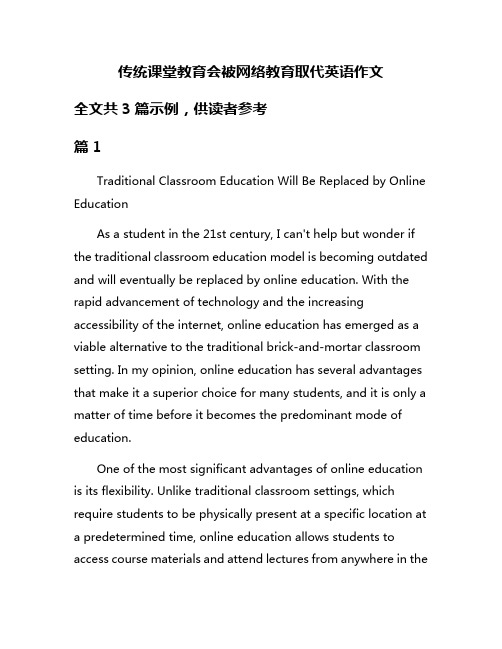
传统课堂教育会被网络教育取代英语作文全文共3篇示例,供读者参考篇1Traditional Classroom Education Will Be Replaced by Online EducationAs a student in the 21st century, I can't help but wonder if the traditional classroom education model is becoming outdated and will eventually be replaced by online education. With the rapid advancement of technology and the increasing accessibility of the internet, online education has emerged as a viable alternative to the traditional brick-and-mortar classroom setting. In my opinion, online education has several advantages that make it a superior choice for many students, and it is only a matter of time before it becomes the predominant mode of education.One of the most significant advantages of online education is its flexibility. Unlike traditional classroom settings, which require students to be physically present at a specific location at a predetermined time, online education allows students to access course materials and attend lectures from anywhere in theworld, as long as they have an internet connection. This flexibility is particularly beneficial for working professionals, parents, or individuals with disabilities who may find it challenging to attend regular classes on campus.Another advantage of online education is itscost-effectiveness. Traditional classroom education often comes with hefty tuition fees, transportation costs, and living expenses, especially for students who attend prestigious universities or those who live far from campus. Online education, on the other hand, typically has lower tuition fees and eliminates the need for commuting or relocating, making it a more affordable option for many students.In addition to flexibility and cost-effectiveness, online education also offers a personalized learning experience. With online courses, students can often learn at their own pace, pause and rewind lectures, and review course materials as many times as they need to fully grasp the concepts. This self-paced learning approach caters to different learning styles and allows students to focus on areas where they need more support, ultimately leading to better comprehension and retention of the material.Moreover, online education provides access to a vast array of courses and programs that may not be available locally.Students can enroll in courses offered by renowned institutions from around the world, exposing them to diverse perspectives and learning from experts in their respective fields. This exposure to global education can broaden students' horizons and better prepare them for careers in an increasingly interconnected world.Despite these advantages, some may argue that online education lacks the personal interaction and social aspects that traditional classroom settings offer. However, with the advancement of technology, online education platforms have incorporated various tools and features to facilitate interaction and collaboration among students and instructors. Video conferencing, discussion forums, and virtual study groups allow students to engage with their peers and instructors, fostering a sense of community and facilitating the exchange of ideas.Furthermore, the COVID-19 pandemic has accelerated the adoption of online education, as educational institutions worldwide were forced to shift to remote learning to ensure the continuity of education during lockdowns and social distancing measures. This sudden transition has highlighted the resilience and adaptability of online education, and many institutions haveinvested in improving their online learning infrastructure and resources.As a student who has experienced both traditional classroom education and online education, I can attest to the benefits and challenges of each approach. While traditional classroom settings offer face-to-face interaction and a structured learning environment, online education provides unparalleled flexibility, accessibility, and personalization. In my opinion, the advantages of online education outweigh its drawbacks, and it is well-positioned to become the predominant mode of education in the future.However, it is important to note that the transition to online education should not be a complete abandonment of traditional classroom settings. Instead, a blended approach that combines the best aspects of both models may be the ideal solution. Institutions could offer a combination of online courses andon-campus experiences, allowing students to benefit from the flexibility and convenience of online learning while still enjoying the social and interactive aspects of traditional classroom settings.Additionally, as online education continues to evolve, it is crucial for educational institutions and instructors tocontinuously improve the quality of online courses, ensure effective delivery of course materials, and provide adequate support and resources for students. Investing in high-quality online learning platforms, incorporating interactive and engaging multimedia content, and fostering a strong online learning community can enhance the overall online education experience.In conclusion, while traditional classroom education has been the predominant mode of education for centuries, the rise of online education has brought about significant changes and opportunities in the educational landscape. With its flexibility, cost-effectiveness, personalized learning experience, and global reach, online education has the potential to revolutionize the way we acquire knowledge and skills. As a student, I believe that online education will continue to gain momentum and eventually become the preferred choice for many learners, paving the way for a more accessible, inclusive, and innovative educational future.篇2Traditional Classroom Education Will Be Replaced by Online EducationAs a student in the modern age of technology, I can't help but wonder if the traditional classroom setting is becoming obsolete. With the rise of online education platforms and the increasing accessibility of the internet, it seems like the future of learning might be heading in a different direction. Don't get me wrong, I love the social aspect of attending classes and interacting with my peers and professors in person, but the convenience and flexibility of online education are hard to ignore.Imagine being able to learn from the comfort of your own home, or even on the go, without the hassle of commuting or adhering to rigid class schedules. Online education allows you to study at your own pace, revisit lectures as many times as needed, and access a wealth of educational resources with just a few clicks. It's like having a virtual library and classroom at your fingertips, available 24/7.But it's not just about convenience; online education also offers a level of personalization that traditional classrooms often struggle to provide. With adaptive learning algorithms and customized curriculums, online courses can tailor the learning experience to individual needs and learning styles. This meansthat students who might struggle in a one-size-fits-all classroom environment could thrive in a more personalized online setting.Additionally, online education opens up a world of opportunities for those who might not have access to quality education due to geographical or financial constraints. By removing the barriers of physical location and expensive tuition fees, online education democratizes learning and makes it accessible to a wider range of people, regardless of their circumstances.Of course, there are valid concerns about the potential drawbacks of online education. Critics argue that it lacks the face-to-face interaction and social dynamics of a traditional classroom, which can be crucial for developing communication and interpersonal skills. There's also the issue of self-discipline and motivation, as online learning requires a higher level of self-regulation and time management.However, these challenges can be addressed through thoughtful course design and the integration of interactive elements, such as virtual classrooms, discussion forums, and collaborative projects. Additionally, the development of new technologies, like virtual reality and augmented reality, could potentially create immersive and engaging online learningexperiences that mimic and even enhance the traditional classroom setting.Another concern is the potential for online education to exacerbate the digital divide, where those without access to reliable internet or technology may be left behind. However, with the increasing availability of affordable devices and the expansion of internet infrastructure, this divide is slowly closing, and online education could actually help bridge the gap by providing access to quality education for underserved communities.Ultimately, I believe that online education will not completely replace traditional classroom education, but rather complement and enhance it. The future of learning lies in a blended approach that combines the best of both worlds – the flexibility and personalization of online education with the invaluable human interaction and social dynamics of a physical classroom setting.Imagine a world where students can attend classes online or in person, seamlessly transitioning between the two based on their needs and preferences. A world where online resources and virtual classrooms supplement and enrich the traditionalclassroom experience, providing a more diverse and engaging learning environment.As we move forward, educational institutions will need to adapt and embrace this shift towards a more integrated approach to learning. They will need to invest in developing high-quality online courses, training faculty in effective online teaching methods, and ensuring that their technology infrastructure can support the demands of online education.For students like myself, this transition presents both challenges and opportunities. We will need to develop strong self-discipline and time management skills to succeed in online learning environments, but we will also have access to a wealth of educational resources and the ability to tailor our learning experiences to our individual needs and goals.Ultimately, the future of education lies in our ability to harness the power of technology while preserving the essential human elements that make learning a transformative and enriching experience. It's an exciting time to be a student, and I can't wait to see how the landscape of education evolves in the years to come.篇3Will Online Learning Replace Traditional Classroom Education?As a student in the 21st century, I can't help but wonder if traditional classroom-based education is becoming obsolete. With the rapid advancements in technology and the increasing popularity of online learning platforms, it's a valid question to ask – will online education eventually replace the traditional classroom setting?Let me start by acknowledging the immense value that traditional classroom education has provided for generations. The physical classroom environment fosters a sense of community, allows for direct interaction between teachers and students, and facilitates collaborative learning experiences. There's something truly special about being physically present in a space dedicated to learning, surrounded by peers who share similar academic goals.However, we can't ignore the numerous advantages that online education offers. Firstly, it provides unparalleled accessibility and flexibility. Students from all walks of life, regardless of their geographical location or personal circumstances, can access high-quality educational resources through online platforms. This democratization of education is agame-changer, as it opens doors for individuals who may have previously faced barriers to traditional classroom-based learning.Secondly, online learning caters to diverse learning styles and paces. Some students thrive in a self-paced environment, where they can revisit complex concepts multiple times until they fully grasp them. Others may prefer the ability to fast-track through material they already understand. Online education accommodates these diverse needs, allowing learners to customize their educational journey in a way that traditional classrooms often struggle to match.Moreover, online learning platforms offer a wealth of multimedia resources that can enhance the learning experience. Interactive simulations, video lectures, and virtual reality applications can bring abstract concepts to life in ways that traditional textbooks and lectures cannot. This multisensory approach to learning can be particularly beneficial for visual and auditory learners, who may struggle in a predominantlytext-based classroom setting.Additionally, online education can foster a more inclusive and diverse learning environment. Students from different cultural backgrounds, geographic regions, and life experiences can engage in virtual discussions, sharing their uniqueperspectives and enriching the learning experience for everyone involved. This exposure to diverse viewpoints can be invaluable in preparing students for an increasingly globalized world.Despite these advantages, it would be naive to assume that online education is a perfect substitute for traditional classroom learning. There are certain aspects of the classroom experience that cannot be easily replicated in a virtual setting. The spontaneous discussions, personal connections, and immediate feedback that occur in a physical classroom can be challenging to replicate online, at least with current technology.Furthermore, some subjects or disciplines may inherently lend themselves better to in-person instruction. Hands-on learning experiences, such as laboratory work in the sciences or studio classes in the arts, may be difficult to fully translate to an online format. Additionally, the social and emotional development that often occurs through face-to-face interactions with peers and teachers cannot be entirely replaced by virtual communication.So, what does the future hold for education? In my opinion, the answer lies not in an either-or scenario but rather in a harmonious blend of traditional classroom learning and online education. The two approaches can complement each other,leveraging their respective strengths to provide a well-rounded and enriching educational experience.Imagine a world where students have access to a diverse range of online resources and virtual learning environments, but also have the opportunity to attend physical classrooms for hands-on learning, collaborative projects, and face-to-face discussions. This hybrid approach could combine the best of both worlds, offering flexibility, accessibility, and personalized learning experiences while still preserving the invaluable benefits of traditional classroom settings.Moreover, online education could potentially enhance traditional classroom learning by providing supplementary resources, virtual tutoring, and collaborative platforms for students and teachers. Conversely, classroom-based education could inform and shape the development of online learning platforms, ensuring that they effectively cater to the diverse needs of learners and foster meaningful interactions.Ultimately, the future of education is not about choosing between traditional classroom learning and online education but rather about finding the optimal balance and integration of both approaches. As a student, I am excited by the prospects of this blended learning environment, where I can benefit from the bestof both worlds while being prepared for the challenges and opportunities of the 21st century.In conclusion, while online education offers numerous advantages in terms of accessibility, flexibility, and personalized learning experiences, it is unlikely to completely replace traditional classroom education. The rich social and collaborative aspects of classroom learning, along with the hands-on experiences necessary for certain subjects, cannot be fully replicated in a virtual setting. However, by embracing a blended approach that combines the strengths of both online and classroom-based learning, we can create a more comprehensive and enriching educational experience for students of all ages and backgrounds. The future of education lies not in choosing one over the other but in finding the perfect harmony between these two powerful modes of learning.。
高校英语词汇“线上+线下”混合教学模式初探——以《新冠肺炎疫情英语词汇》为例
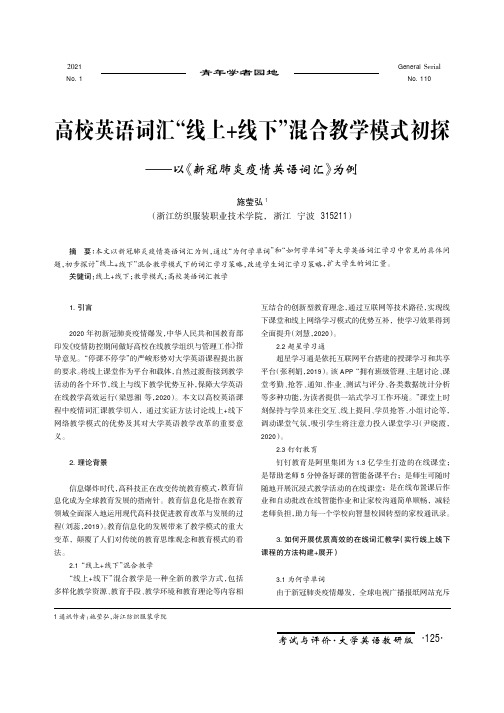
青年学者园地General Serial No.1102021No.1高校英语词汇“线上+线下”混合教学模式初探———以《新冠肺炎疫情英语词汇》为例施莹弘1(浙江纺织服装职业技术学院,浙江宁波315211)摘要:本文以新冠肺炎疫情英语词汇为例,通过“为何学单词”和“如何学单词”等大学英语词汇学习中常见的具体问题,初步探讨“线上+线下”混合教学模式下的词汇学习策略,改进学生词汇学习策略,扩大学生的词汇量。
关键词:线上+线下;教学模式;高校英语词汇教学1.引言2020年初新冠肺炎疫情爆发,中华人民共和国教育部印发《疫情防控期间做好高校在线教学组织与管理工作》指导意见。
“停课不停学”的严峻形势对大学英语课程提出新的要求。
将线上课堂作为平台和载体,自然过渡衔接到教学活动的各个环节,线上与线下教学优势互补,保障大学英语在线教学高效运行(梁恩湘等,2020)。
本文以高校英语课程中疫情词汇课教学切入,通过实证方法讨论线上+线下网络教学模式的优势及其对大学英语教学改革的重要意义。
2.理论背景信息爆炸时代,高科技正在改变传统教育模式,教育信息化成为全球教育发展的指南针。
教育信息化是指在教育领域全面深入地运用现代高科技促进教育改革与发展的过程(刘蕊,2019)。
教育信息化的发展带来了教学模式的重大变革,颠覆了人们对传统的教育思维观念和教育模式的看法。
2.1“线上+线下”混合教学“线上+线下”混合教学是一种全新的教学方式,包括多样化教学资源、教育手段、教学环境和教育理论等内容相互结合的创新型教育理念,通过互联网等技术路径,实现线下课堂和线上网络学习模式的优势互补,使学习效果得到全面提升(刘慧,2020)。
2.2超星学习通超星学习通是依托互联网平台搭建的授课学习和共享平台(张利娟,2019)。
该APP“拥有班级管理、主题讨论、课堂考勤、抢答、通知、作业、测试与评分、各类数据统计分析等多种功能,为读者提供一站式学习工作环境。
线上教学英文作文六级
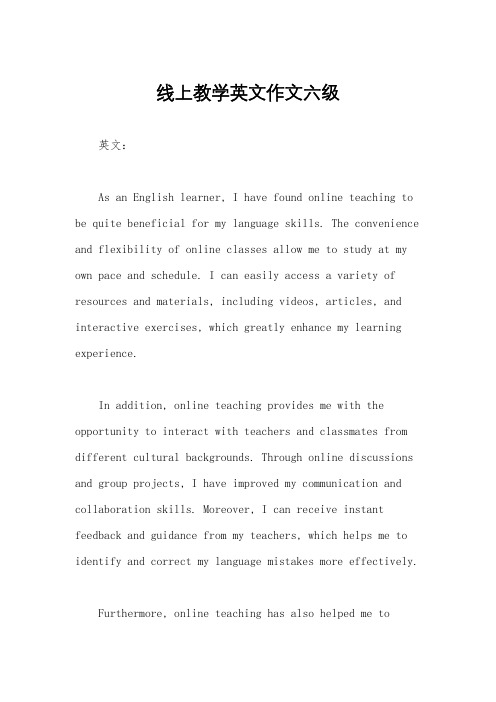
线上教学英文作文六级英文:As an English learner, I have found online teaching to be quite beneficial for my language skills. The convenience and flexibility of online classes allow me to study at my own pace and schedule. I can easily access a variety of resources and materials, including videos, articles, and interactive exercises, which greatly enhance my learning experience.In addition, online teaching provides me with the opportunity to interact with teachers and classmates from different cultural backgrounds. Through online discussions and group projects, I have improved my communication and collaboration skills. Moreover, I can receive instant feedback and guidance from my teachers, which helps me to identify and correct my language mistakes more effectively.Furthermore, online teaching has also helped me todevelop self-discipline and time management skills. I have learned to set goals, stay motivated, and stay organized in order to make the most of my online learning experience. This has not only improved my English proficiency, but also my overall study habits and work ethic.Overall, I believe that online teaching has greatly contributed to my English learning journey, and I am grateful for the opportunities it has provided me to improve my language skills.中文:作为一个英语学习者,我发现线上教学对我的语言能力非常有益。
教学模式新体验线上线下融合教学——以高职学校计算机应用基础课程为例
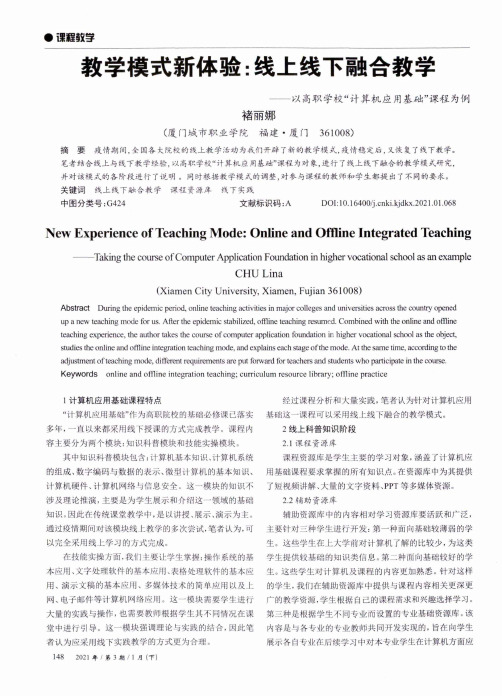
• i果酲教穿教学模式新体验:线上线下融合教学—以高职学校“计算机应用基础”课程为例褚丽娜(厦门城市职业学院福建•厦门361008)摘要疫情期间,全国各大院校的线上教学活动为我们开辟了新的教学模式,疫情稳定后,又恢复了线下教学。
笔者结合线上与线下教学经验,以高职学校“计算机应用基础”课程为对象,进行了线上线下融合的教学模式研究,并对该糢式的各阶段进行了说明。
同时根据教学模式的调整,对参与课程的教师和学生都提出了不同的要求。
关键词线上线下融合教学课程资源库线下实践中图分类号:G424 文献标识码:A DOI:10.16400/ki.kjdkx.2021.01.068 New Experience of Teaching Mode: Online and Offline Integrated Teaching—Taking the course of C omputer Application Foundation in higher vocational school as an exampleCHU Lina(Xiamen City University, Xiamen, Fujian 361008)Abstract During the epidemic period,online teaching activities in m ajor colleges and universities across the country opened up a new teaching mode for us.After the epidemic stabilized,offline teaching bined with the online and offline teaching experience,the author takes the course of computer application foundation in higher vocational school as the object^ studies the online and offline integration teaching mode,and explains each stage of t he mode.At the same time,according to the adjustm ent of t eaching mode,different requirements are put forw ard for teachers and students who participate in the course.Keywords online and offline integration teaching;curriculum resource library;offline practice1计算机应用基础课程特点“计算机应用基础”作为高职院校的基础必修课己落实 多年,一直以来都采用线下授课的方式完成教学。
An Empirical Study of Blended Teaching Mode in ESP Teaching Practice

Sino-US English Teaching, September 2019, Vol. 16, No. 9, 394-399doi:10.17265/1539-8072/2019.09.005An Empirical Study of Blended Teaching Mode in ESPTeaching PracticeHAN Jia-jiaBinzhou University, Binzhou, ChinaTraditional college English teaching ideas and methods cannot meet the current needs of talents in modern society;simultaneously, with the continuous deepening of college English teaching reform, ESP (English for SpecificPurpose) has become the mainstream of English teaching and research. While Blended Learning combines onlinedigital media with traditional classroom methods, which are of great significance to change the traditional ESPclassroom teaching mode, it will significantly improve the effects of English teaching. In this study, ESP BlendedInstruction Mode at School of Flight Training in Binzhou University is taken as the research object, and theempirical research is conducted by means of questionnaire survey. The experiment shows that the BlendedInstruction Mode has more advantages in improving college students’ ESP application ability and is helpful tostimulate their interest in learning, and further enhance their ESP listening, speaking, reading, and writingperformance. Teachers have also been greatly improved in this teaching mode, and more targeted suggestions havebeen put forward.Keywords: Blended Teaching Mode, ESP (English for Specific Purpose), empirical researchIntroductionAs an important part of college curriculum, ESP (English for Specific Purpose) has many characteristics such as highly professional, boring, and so on. As a result, traditional teaching methods are getting more and more difficult in ESP teaching. With the rapid development of Internet technology and popularization of a large number of digital mobile devices, human society has entered a brand new era of Internet. Internet technology undoubtedly provides a broader space for college English teaching, but it also poses a more serious challenge to the times. Under this background, the concept of Blended Learning or Teaching came into being. This model combines online learning with classroom face-to-face teaching, and can theoretically form complementary advantages of these two modes, so more and more researchers pay more attention to it. However, this mode has rarely been reported in practical teaching and application. This study intends to build the ESP Blended Teaching Mode under the background of the Internet, and conducts experimental research so as to analyze the reasons that affect the Blended Instruction. Based on this, some countermeasures are proposed to improve the quality of ESP teaching.Acknowledgements: This work was supported by the Education Science “13th Five-Year” Planning Project of Binzhou City (BJK13517-31) and Scientific Research Project of Binzhou University (BZXYRW1609).HAN Jia-jia, master, lecturer, School of Flight Training, Binzhou University, Binzhou, China.AN EMPIRICAL STUDY OF BLENDED TEACHING MODE IN ESP TEACHING PRACTICE 395Blended Learning TheoryProfessor He Kekang (2004a, pp. 23-35) said: “The so-called Blending Learning is the combination of the advantages of traditional learning methods and E-learning (i.e., digital or network learning)”. The teacher should play a dominated role in guiding, inspiring, and monitoring the teaching process, simultaneously giving full play to students’ initiative, enthusiasm, and creativity in the process of learning. Only by combining the two can we reinforce complementary advantages, thus achieving the best learning result.The traditional educational thought of classroom teaching mode regards teachers as the center, neglects the initiative of the students, and is a cramming teaching method. In the process of teaching, both teachers and students should perform their own duties instead of being over their own. Now, it is advocated that Blending Learning emphasizes the combination of the two. Obviously, this is a major shift in educational thinking and teaching concepts in the international educational technology community.The Blended Learning is a new type of teaching strategy based on the web environment in the current era. It can make the learning time, learning style, learning technology, learning ability, and learning effect be integrated in a diversified way in order to optimize the efficiency of the learning process. Blended Instruction is considered by many scholars to be an inspiring, monitoring, and instructional teaching activity in the context of multiple resource modules. It combines educational theory with educational technology, and expands in both the student’s learning and thinking space, indirectly cultivating the learner’s self-monitoring ability, and ultimately improving the teaching effect. At the same time, Blended Learning increases the flexibility of learners in all aspects of the learning process, such as learning time, learning location, learning speed, and learning path, which will change according to the change of the learning subject. In the process of learning, teaching and student learning are an interactive process, which is also in line with the Blended Learning Theory.Literature ReviewESP refers to English for Specific Purpose. It is not only a new discipline, but also a teaching organization itself. “Specialization” refers to the purpose, not the language itself.In the 1960s, the publishment of Strevens’ book The Linguistic Sciences and Language Learning (1964) and Ewer’s ESP textbook A Course in Basic Science English (1969) symbolized the beginning of ESP study (Hutchinson & Waters, 2002, pp. 9-10).During the past half century, ESP research in foreign countries has made remarkable progress. Currently in major universities of Europe and the United States, ESP studies mainly come in the form of Academic English and Professional English. The researchers are mainly English teachers, teaching both English majors and non-English majors. Research areas cover all aspects of ESP research practice such as ESP classification, teaching methods, requirements analysis, textbook design, teacher training, corpus research, and assessment testing (Gu, 2010, pp. 25-29).In the 1980s, China’s ESP study gradually emerged due to the need of foreign exchanges in the fields of natural sciences, humanities, social sciences, and so on. According to statistics collected by Jiang Yichao (2010, pp. 104-109), on the related articles of ESP from 1985 to 2008, “There are at least 110 ESP research articles in at least 10 core journals of foreign languages”, and the total number of articles published in the general core journals and ordinary journals is even greater. However, it must be admitted that most of ESP studies in ourAN EMPIRICAL STUDY OF BLENDED TEACHING MODE IN ESP TEACHING PRACTICE396 country are based on linguistics and related theories or introduction of research trends in foreign ESP studies.To sum up, ESP application research in foreign countries has gradually entered the field of demand-centered practical researches such as “Academic English” and “Professional English” from ESP theoretical research. Domestic ESP research is gradually shifting from introducing ESP theory in the west as well as emphasizing the importance of ESP to ESP case studies and analyzing the problems of ESP application as well as putting forward solutions. However, on the whole, the domestic ESP research needs to be strengthened in terms of practical research, especially the case study of specific applied research.Research DesignResearch PurposesThe main purpose of this study is to verify the subjective value of the Blended Teaching Mode in mobilizing students’ initiative and creativity of learning English and to verify whether teachers can play a leading role in the Blended Teaching Mode.Research QuestionTo verify the effectiveness of the college ESP Blended Teaching Mode, we conducted a one-semester experiment. The experimental hypotheses are as follows:(1) Is the Blended Teaching Mode more advantageous than the traditional classroom teaching mode in improving the students’ ESP application ability and academic performance?(2) The Blended Teaching Mode can not only improve the ESP ability of students but also improve the comprehensive English knowledge level.SubjectsThe subjects selected in this study were 54 sophomores of Binzhou University majoring flight technology, and then randomly divided them into two classes. Two classes are taught by the same teacher, and have the same teaching hours and teaching conditions. Among the 50 students, 90% had computers, of which 50% had laptops equipped with wireless Internet access, and 100% of students have internet access, smart phones, or other kinds of digital learning machines.InstrumentsQuestionnaire. Before the experiment, we obtained students’ ESP learning ability through the questionnaire. After the experiment, we used the questionnaire to investigate the impact of Blended Teaching Mode on ESP learners’ learning ability.Interview. After interviews with teachers, we know the problems they face during the teaching process and how to solve them, and discuss the feasibility of promoting this ESP teaching model in a wide range. While interviews with the students help us understand the students’ adaptability to this model, it will improve and perfect this teaching model in the future.ProceduresThis study takes a lesson (45 minutes) as an example, and the experimental class adopted a Blended Teaching Mode while control class adopted the traditional teaching mode. Before the experiment, the English listening, speaking, and comprehensive knowledge pre-tests were conducted. After two months’ experiment, a pro-test was conducted for comparison and questionnaires were sent to students as well as teachers; besides,AN EMPIRICAL STUDY OF BLENDED TEACHING MODE IN ESP TEACHING PRACTICE 397interviews were also arranged simultaneously so as to know their evaluation of the teaching and learning effect of these two kinds of teaching modes.Data Collection and Results AnalysisTest results analysis. Before the start of the experiment, we randomly selected the experimental class and the control class and conducted the pre-test. The statistical results are shown in Table 1. As can be seen from Table 1, before the experiment, the average listening score difference of the two classes was 0.14, oral was 0.13, reading was 0.19, and writing was 0.27, thus there is no significant difference. However, after two months’ experiment, as can be seen from Table 2, both the experiment class and the control class have improved their listening, speaking, intensive reading, and writing performance. Among them, the average score of listening comprehension test in experimental class was increased by 7.73, control class was increased by 2.78, and the difference was 4.95; average score of oral test in the experimental class was increased by 13.37, control class was 5.44, and the difference was 7.93; the average score of reading test in the experimental class was increased by 8.5, control class was 1.71, and the difference was 6.9; the average score of writing test in the experimental class was increased by 9.17, control class was 3.16, and the difference was 6.01. Thus, the pro-test results show clearly that the experimental class and control class had obvious difference in score improvement.Table 1Students’ Pre-test Score StatisticsScores Class Number AverageListening Experiment class 40 75.62 Control class 40 75.48Speaking Experiment class 40 65.25 Control class 40 65.12Reading Experiment class 40 81.23 Control class 40 81.04Writing Experiment class 40 72.45 Control class 40 72.18Table 2Students’ Pro-test Score StatisticsScores Class Number AverageListening Experiment class 40 83.35 Control class 40 78.26Speaking Experiment class 40 78.62 Control class 40 70.56Reading Experiment class 40 89.73 Control class 40 82.75Writing Experiment class 40 81.62 Control class 40 75.34Through the questionnaire and interview survey of teachers and students involved in Blended Teaching, it is found that teachers and students have a deeper understanding of the advantages of this kind teaching mode than traditional college English teaching. Teachers and students generally agree that teachers can not only greatly stimulate their interest in learning English courses, but students’ self-learning ability has also been significantly improved under Blended Teaching Mode. And the leading role of teachers in the teaching processAN EMPIRICAL STUDY OF BLENDED TEACHING MODE IN ESP TEACHING PRACTICE398 can also be fully reflected; the teaching effect has also been significantly improved compared with the traditional course teaching.Findings1. From students’ perspective:(1) Students basically have no barriers to the use of Internet devices, and the application of Internet technology makes ESP learning more flexible, because students can make full use of after-hours for effective learning anytime, anywhere.(2) Most students think the preview part which can be prepared in advance for the contents of class by use of internet is quite necessary and beneficial. It can not only help some shy and inferior students to overcome their psychological barrier, but also make the interaction between teachers and students or among students be conducted in depth.(3) The combination of learning content with the real work situation can stimulate students’ interest in learning English. Most students think that ESP language training helps students to accumulate professional vocabulary and promote the improvement of ESP comprehensive application ability.2. From perspective of teachers:Teachers experience mainly in the following aspects:(1) Blended Teaching and Learning Mode cultivates the feelings of teachers and students and is conducive to carry out personalized teaching.(2) Formative evaluation makes students be willing to participate in interactive activities; the classroom atmosphere is more active.(3) In the process of preparing learning contents such as video and audio clips and carrying out bracket-based teaching, teachers further enriched their professional knowledge and teaching experience, which was rare in previous teaching.ImplicationsFirst of all, under the Blended Instruction, in order to ensure the integrity of the entire teaching process, teaching process and teaching design must follow the teaching objectives; only in this way can the continuity of teaching and learning process be guaranteed.Second, teachers should know clearly the relations between online teaching and classroom teaching. Classroom teaching is mainly focused on teaching materials, while online teaching is mainly to highlight the extension of extra-curricular knowledge.Third, teachers should ensure that online teaching and classroom teaching have good complementarity and try their best to ensure that the effects of teaching and learning can be maximized.Finally, in the process of Blended Instruction, both teachers and students should develop the habit of continuous reflection and constantly find deficiencies in the teaching and learning process so as to improve the teaching and learning effects through problem improvement.In response to the status quo, universities should provide teachers with a full range of school-based training in terms of Blended Teaching concepts, skills of curriculum utilization and development, and teaching activities’ design and implementation. This kind of training should be conducted in a combination of theory and practice, focusing on showing teachers a variety of cases of Blended Instruction, so as to provide a reference paradigm for teachers’ further development.AN EMPIRICAL STUDY OF BLENDED TEACHING MODE IN ESP TEACHING PRACTICE 399ConclusionIn the background of Internet, the Blended Instruction of ESP is the inevitable choice to cope with the change of the times. In fact, using the advantages of Internet technology to build a Blended Teaching and Learning environment can improve the efficiency, effects, and benefits of learning, which is a beneficial attempt to deeply integrate information technology with the curriculum. This study constructed an ESP Blended Teaching Mode, conducted empirical research, and put forward the counter measures to promote Blended Teaching. In view of the shortcomings of this study, similar studies should further optimize this teaching model in the future, expand the scope of practical samples and research as much as possible, and implement more rigorous teaching and experimental research to enhance the scientific and universality of the research results.ReferencesGu, Z. (2010). Analysis of the status quo of ESP teaching in colleges and universities and coping strategies. Computer-Assisted Foreign Language Education, 2, 25-29.He, K. (2004a). The new development of education technology theory from perspective of blending learning. E-Education Research, 13(3), 23-25.He, K. (2004b). The new development of education technology theory from perspective of blending learning. E-Education Research, 14(4), 28-30.He, K. (2009). Comparative analysis of the integration of information technology and curriculums in domestic and abroad. China Educational Technology, 20(9), 22-24.Huang, P. (2017). Review and prospect of ESP research at home and abroad (1981-2011). ESP Research in China, 1, 1-11. Hutchinson, T., & Waters, A. (2002). English for specific purposes. Shanghai: Shanghai Foreign Language Education Press. Jiang, Y., & Li, N. (2010). Domestic special purpose English research for 20 years: review and reflection. Journal of Ningbo University (Educational Science Edition), 32(2), 104-109.Jordan, R. (1997). English for academic purposes: A guide and resource book for teachers. Cambridge: Cambridge University Press.Serkan, C. (2013). Internet-assisted technologies for English language teaching in Turkish universities. Computer Assisted Language Learning, 5, 22-26.Stake, H., & Horn, M. B. (2012). Classifying K-12 blended learning. Innosight Institute, 5, 65.Strevens, P. (1988). ESP after twenty years: A re-appraisal. In M. Tickoo (Ed.), ESP: State of the art (pp. 1-13). Singapore: SEAMEO Regional Language Centre.Wang, J. K., & Chen, J. (2015). Application and development of educational information technology in ESP teaching. Technology Enhanced Foreign Language Education, 1, 62-66.。
(2024年)新东方官方网校剑桥英语培训课程

要点二
Flexible scheduling
Online live courses allow for flexible scheduling, making it convenient for students to learn according to their own time.
要点三
Efficient learning
2024/3/26
Learning objective
Through systematic course learning and practice, improve students' English language abilities, achieve the level of passing the Cambridge English exam, and lay a solid foundation for future learning and work.
Live courses usually have a playback function, allowing students to watch repeatedly, deepen understanding, and improve learning efficiency.
2024/3/26
13
Interactive learning experience
Group Discussion
Role playing
Interactive games
In the course, a group discussion session will be arranged where students can discuss problems, share viewpoints, and improve their oral expression skills with their classmates.
“线上+线下”混合式教学法在基础化学实验教学中的应用

力,为学生创新能力的发展及科学素养的提高奠定坚实的基础,以期为后续开展的教学模式改革提供重要参考。
1 “线上+线下”混合教学法的概念“线上+线下”混合教学法,是基于“互联网+”发展而建立起来的一种全新的教学形式,将一些慕课、微课等为代表的优质线上网络资源引入到面对面的线下课堂教学过程中,形成以线下面对面实体教学为主,线上各种优质网络资源为辅的混合式教学模式,通过两者优势互补,构建创新性的教学体系[4]。
“线上+线下”混合教学法最大的亮点在于可充分应用各种先进网络教学资源,优化各类教学资源的利用率,实现各类教学资源之间的合理、有效配置,合理解决教学资源分布不均衡问题,实现较短时间内大面积的推广及应用。
2 传统实验教学模式存在的问题在传统面对面的现实课堂教学中,课堂理论教学的进度和课堂实验教学的进度并不是完全同步的,实验课堂教学的进度往往早于课堂理论教学的进度。
因此,大部分的学生在实验教学课堂中,仅是简单机械性地重复抄写理论知识,按照实验教材中实验流程、操作机械性的模仿并处理相应实验数据及结果,最终的结果是导致大部分实验课堂教学效果根本无法得到保证。
传统实验教学模式的弊端和不足主要表现:首先是实验课前预习效果达不到预期的目标,效果不佳。
主要原因在于学生手头的实验项目预习资源相对贫乏,学生只能通过现有实验教材的学习实现课前预习任务,凭借实验教材上有限的文字内0 引言国家高等教育的重要任务之一是高度重视学生能力素质的提升,适应新时代发展专业应用型创新人才的培养。
高等院校本科生实践能力及创新能力的培养很大程度上是通过实验教学实现的。
因此,实验教学不仅是课堂理论知识掌握程度的确认,更是培养学生科研能力、探索精神及创新意识的关键,也是实现高等教育人才培养目标的重要环节。
深化实验教学改革,提高实验教学质量,是现阶段高等院校教学改革的重要内容[1-3]。
基础化学实验是我校非化学、化工类专业必修的一门重要基础课程,是学生实践能力和创新意识培育的主要载体,是创新型应用人才培养的有效方式。
教育培训的全英文授课模式
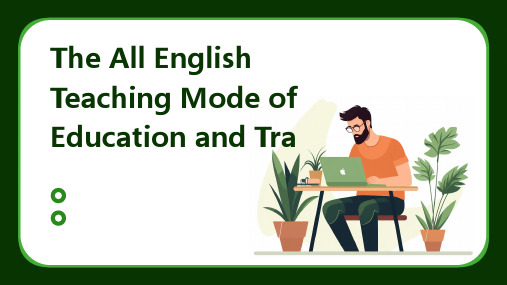
目录
• Overview of Full English Teaching Mode
• The advantages of the all English teaching mode
• The Challenges and Solutions of Full English Teaching Mode
The Importance of Full English Teaching Mode
Enhance English proficiency
The Full English Teaching Mode provides students with a natural and immersive environment to learn and use English, promoting their language skills and cross cultural understanding
Teachers who are not native English speakers may face difficulties in delivering clear and accurate instructions in English
Increased fluency
The all English teaching mode encourages students to speak and think in English, leading to increased fluency and a more natural language flow This is particularly beneficial for students who are learning English as a second language
上网课传统授课英语作文
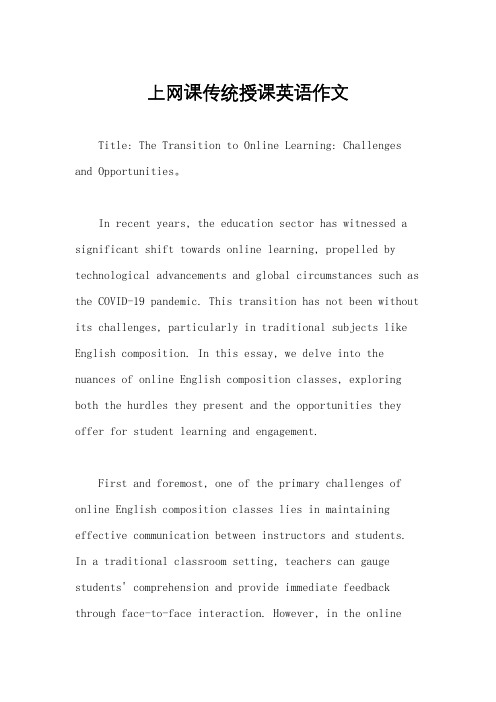
上网课传统授课英语作文Title: The Transition to Online Learning: Challenges and Opportunities。
In recent years, the education sector has witnessed a significant shift towards online learning, propelled by technological advancements and global circumstances such as the COVID-19 pandemic. This transition has not been without its challenges, particularly in traditional subjects like English composition. In this essay, we delve into the nuances of online English composition classes, exploring both the hurdles they present and the opportunities they offer for student learning and engagement.First and foremost, one of the primary challenges of online English composition classes lies in maintaining effective communication between instructors and students. In a traditional classroom setting, teachers can gauge students' comprehension and provide immediate feedback through face-to-face interaction. However, in the onlineenvironment, this dynamic changes. Students may feel isolated and struggle to express themselves effectively without the direct guidance of their instructors. Moreover, technological glitches and connectivity issues can further impede communication, hindering the learning process.Another significant hurdle in online English composition classes is the lack of physical presence, which can diminish students' motivation and accountability. In a traditional classroom, the physical presence of peers and instructors creates a sense of community and fosters healthy competition, encouraging students to strive for excellence. In contrast, the virtual classroom may feel impersonal, making it easier for students to become disengaged and lose focus on their academic goals.Furthermore, the transition to online learning presents challenges in adapting instructional methods to suit the digital format effectively. Traditional methods of teaching English composition, such as in-class discussions and peer reviews, may not translate seamlessly to the online environment. Instructors must explore innovative approachesto engage students and facilitate meaningful interactions while ensuring that learning objectives are met.Despite these challenges, online English composition classes also offer numerous opportunities for enhancing student learning and academic achievement. One such opportunity lies in the flexibility and accessibility afforded by online platforms. With asynchronous learning options, students can access course materials and complete assignments at their own pace, accommodating diverselearning styles and schedules. Additionally, the use of multimedia tools and interactive resources can enrich the learning experience, providing students with dynamic opportunities to engage with course content.Moreover, online English composition classes provide a valuable opportunity for cultivating digital literacyskills, which are increasingly essential in today's technology-driven world. Through online forums,collaborative writing platforms, and digital research tools, students can develop proficiency in navigating andcritically evaluating digital information—a skill set thatis highly transferable to various academic and professional contexts.Furthermore, online learning encourages students to take ownership of their learning journey and develop self-discipline and time management skills. Without thestructure of a traditional classroom setting, students must learn to prioritize tasks, manage deadlines, and seek support when needed, fostering independence and resilience.In conclusion, while online English composition classes pose unique challenges, they also offer valuable opportunities for student learning and growth. By leveraging technology effectively and embracing innovative instructional methods, instructors can create engaging and inclusive learning environments that empower students to succeed. Ultimately, the transition to online learning represents not only a response to external circumstances but also a catalyst for reimagining and enhancing the educational experience for students around the globe.。
新课程英语教学方法

翻转课堂教学模式将传统课堂教学与在线学习相结合,学生在课前通过观看视频、阅读资料等方式自主学习新知 识,课堂上则进行问题讨论、作业完成等活动,强化对知识的理解和运用。这种模式能够激发学生的学习兴趣和 主动性,提高学习效果。
03
The Application of English Teaching
The Application of Flipped Classroom Method in English Listening
• Flipped classroom method is a teaching method that reverses the traditional teaching mode. It emphasizes on students' autonomous learning and exploration before class, and teachers' guidance and assistance in class.
Methods in the New Curriculum
The application of task-based teaching method in English reading
• Task-based teaching method emphasizes on students' practical ability and language application ability. It is a teaching method that combines language learning with communicative ability.
• Through situational teaching method, students can better understand English in real life and use English in real life, and cultivate their language communication ability and thinking ability.
网上授课的相关英语作文
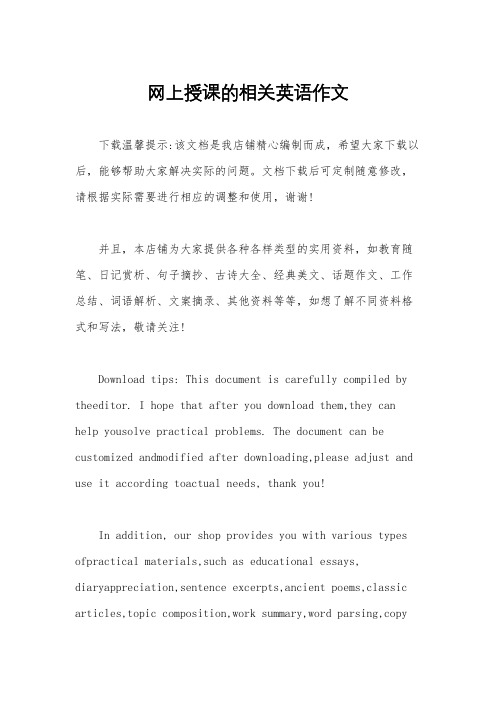
网上授课的相关英语作文下载温馨提示:该文档是我店铺精心编制而成,希望大家下载以后,能够帮助大家解决实际的问题。
文档下载后可定制随意修改,请根据实际需要进行相应的调整和使用,谢谢!并且,本店铺为大家提供各种各样类型的实用资料,如教育随笔、日记赏析、句子摘抄、古诗大全、经典美文、话题作文、工作总结、词语解析、文案摘录、其他资料等等,如想了解不同资料格式和写法,敬请关注!Download tips: This document is carefully compiled by theeditor. I hope that after you download them,they can help yousolve practical problems. The document can be customized andmodified after downloading,please adjust and use it according toactual needs, thank you!In addition, our shop provides you with various types ofpractical materials,such as educational essays, diaryappreciation,sentence excerpts,ancient poems,classic articles,topic composition,work summary,word parsing,copyexcerpts,other materials and so on,want to know different data formats andwriting methods,please pay attention!Sure, here's a piece of content for an online teaching-related English composition without a specific structure or logical flow. Keep in mind, this is a casual and conversational style:1.Plop, sit down, and let's chat! You know, this digital classroom is more than just a screen, it's a global hub of learning. It's like a magic portal where ideas bounce and knowledge travels at lightning speed.2.Imagine, a world where a click can connect you to a tutor in a far-off land, teaching you Shakespeare's sonnets with a twinkle in their eye. It's a virtual classroom, where the walls are made of Wi-Fi and the lessons are as interactive as a game of Pictionary.3.The pandemic might have forced us to our computers, but it's also made online teaching a reality. It's like a 24/7 library, open to all, no matter the time or the weather.It's a place where every student is a participant, not just a listener.4.But, let's not forget the challenges. Technicalglitches can be as frustrating as a lost password, but the persistence and adaptability of students? That's a lessonin itself. They're the ones turning the cursor into a compass, navigating through the digital sea.5.And then, there's the magic of interaction. It's not just about the words, it's about the exchange of ideas, the instant feedback, and the shared laughter. It's a virtualclassroom where every 'like' is a pat on the back.6.So, here's to the online teaching, a place where knowledge meets convenience, and learning never sleeps.It's a chatroom, a classroom, a world, all rolled into one.Remember, this is a snapshot of the online teaching experience, a snapshot that's always evolving. The story, the lessons, they're all in the mix, waiting to be discovered in each online session.。
关于写网上上课英语作文
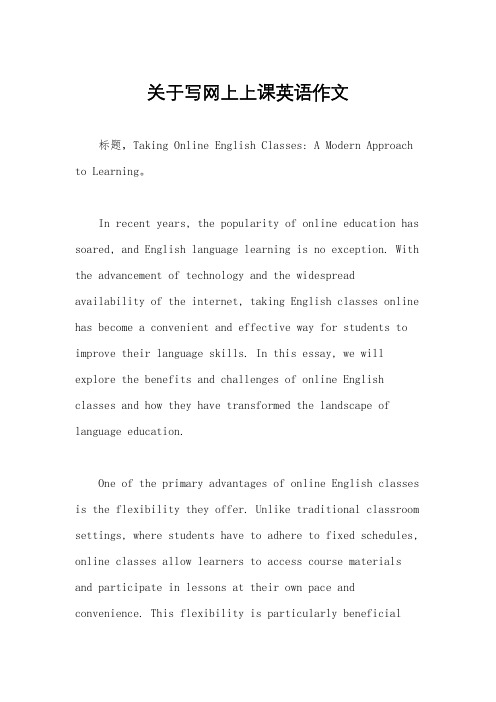
关于写网上上课英语作文标题,Taking Online English Classes: A Modern Approach to Learning。
In recent years, the popularity of online education has soared, and English language learning is no exception. With the advancement of technology and the widespreadavailability of the internet, taking English classes online has become a convenient and effective way for students to improve their language skills. In this essay, we will explore the benefits and challenges of online English classes and how they have transformed the landscape of language education.One of the primary advantages of online English classes is the flexibility they offer. Unlike traditional classroom settings, where students have to adhere to fixed schedules, online classes allow learners to access course materials and participate in lessons at their own pace and convenience. This flexibility is particularly beneficialfor individuals with busy schedules or those who are unable to attend in-person classes due to various commitments.Furthermore, online English classes provide access to a wide range of resources and materials that may not be available in traditional classrooms. Through online platforms, students can access interactive lessons, multimedia resources, and language learning apps that cater to different learning styles and preferences. Additionally, online classes often offer opportunities for real-time communication with instructors and fellow classmatesthrough video conferencing, chat rooms, and discussion forums, facilitating collaborative learning and interaction.Another significant advantage of online English classes is their accessibility. Regardless of geographical location or time zone, students from around the world can enroll in online courses and engage with English language learning materials. This global accessibility not only fosters cultural exchange and diversity but also enablesindividuals to connect with instructors and peers from different backgrounds, enhancing their learning experienceand broadening their perspectives.Moreover, online English classes can be tailored to meet the specific needs and goals of individual learners. Whether it's improving conversational skills, preparing for standardized tests like the TOEFL or IELTS, or mastering grammar and vocabulary, online courses offer customizable learning paths and personalized feedback to address each student's strengths and weaknesses. This individualized approach to learning ensures that students receive the support and guidance they need to succeed in their language learning journey.However, despite the numerous benefits, online English classes also present certain challenges. One of the main concerns is the lack of face-to-face interaction with instructors and classmates, which may hinder some students' ability to fully engage with the material and participatein discussions. Additionally, technical issues such as poor internet connectivity or software glitches can disrupt the learning process and cause frustration for both students and instructors.Furthermore, the self-discipline and motivation required for online learning can be demanding for some individuals, as it requires them to take initiative and manage their time effectively without the structure and supervision of a traditional classroom environment. Without proper motivation and self-discipline, students may struggle to stay focused and committed to their studies, leading to a lack of progress and achievement.In conclusion, online English classes offer a modern and innovative approach to language learning, providing flexibility, accessibility, and personalized instruction to students around the world. While they may present challenges such as limited face-to-face interaction and the need for self-discipline, the benefits they offer far outweigh the drawbacks. With the continued advancement of technology and the growing demand for English language skills in today's globalized world, online classes are likely to remain a popular and effective option for learners seeking to improve their English proficiency.。
网络教学和课堂教学的区别英语作文
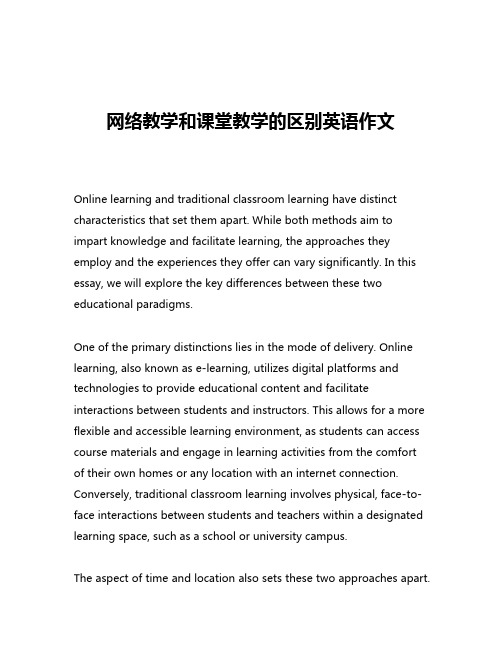
网络教学和课堂教学的区别英语作文Online learning and traditional classroom learning have distinct characteristics that set them apart. While both methods aim to impart knowledge and facilitate learning, the approaches they employ and the experiences they offer can vary significantly. In this essay, we will explore the key differences between these two educational paradigms.One of the primary distinctions lies in the mode of delivery. Online learning, also known as e-learning, utilizes digital platforms and technologies to provide educational content and facilitate interactions between students and instructors. This allows for a more flexible and accessible learning environment, as students can access course materials and engage in learning activities from the comfort of their own homes or any location with an internet connection. Conversely, traditional classroom learning involves physical, face-to-face interactions between students and teachers within a designated learning space, such as a school or university campus.The aspect of time and location also sets these two approaches apart.Online learning offers a high degree of flexibility, as students can typically access course materials and complete assignments at their own pace and on their own schedule. This can be particularly beneficial for individuals with busy lifestyles, those living in remote areas, or those who prefer to learn at their own convenience. Classroom learning, on the other hand, is bound by a fixed schedule, with classes taking place at specific times and locations. Students are required to be physically present in the classroom to attend lectures, participate in discussions, and engage with their peers and instructors.The learning environment and social interactions also differ significantly between online and classroom learning. In a traditional classroom setting, students have the opportunity to engage in direct, face-to-face discussions, collaborate with their peers, and receive immediate feedback and guidance from their instructors. This can foster a sense of community, promote social learning, and allow for more immediate and nuanced communication. Online learning, while offering the advantage of flexibility, can sometimes lack the same level of personal interaction and social dynamics. However, many online learning platforms now incorporate features like video conferencing, discussion forums, and virtual group projects to facilitate more interactive and collaborative learning experiences.The role of the instructor also varies between the two approaches. Ina traditional classroom setting, the instructor typically takes a more active and direct role in delivering lectures, leading discussions, and providing personalized attention to students. They can observe students' reactions, gauge their understanding, and adjust their teaching methods accordingly. In an online learning environment, instructors may need to adopt a more facilitative role, designing engaging course materials, providing timely feedback, and moderating online discussions to ensure an effective learning experience. However, advancements in technology have enabled online instructors to incorporate interactive elements, such as live video sessions, virtual office hours, and personalized feedback, to enhance the level of instructor-student interaction.The assessment and evaluation methods also differ between online and classroom learning. In a traditional classroom setting, assessments often involve in-person exams, presentations, and group projects that allow instructors to directly observe and evaluate student performance. Online learning, on the other hand, may rely more heavily on digital assessments, such as quizzes, written assignments, and projects submitted through online platforms. While this can offer more flexibility and convenience, it may also present challenges in ensuring academic integrity and authenticity of student work.Finally, the overall learning experience and outcomes can also varybetween the two approaches. Classroom learning can provide a more immersive and engaging experience, with the opportunity for hands-on activities, experiential learning, and the immediate exchange of ideas and perspectives. Online learning, however, can offer a more self-directed and personalized learning experience, allowing students to revisit course materials, pause and review content, and engage with the material at their own pace. The effectiveness of each approach may depend on the individual learning preferences, the subject matter, and the specific educational goals.In conclusion, the key differences between online learning and traditional classroom learning lie in the mode of delivery, the aspect of time and location, the learning environment and social interactions, the role of the instructor, the assessment and evaluation methods, and the overall learning experience and outcomes. While both approaches have their strengths and weaknesses, the choice between the two often depends on the individual's learning needs, preferences, and the specific educational context. As technology continues to evolve, the lines between online and classroom learning may become increasingly blurred, leading to the emergence of hybrid or blended learning models that combine the best of both worlds.。
网上上学的英语作文
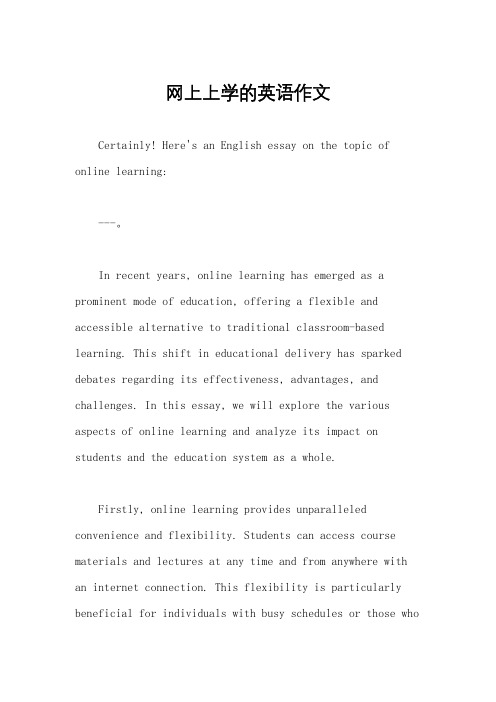
网上上学的英语作文Certainly! Here's an English essay on the topic of online learning:---。
In recent years, online learning has emerged as a prominent mode of education, offering a flexible and accessible alternative to traditional classroom-based learning. This shift in educational delivery has sparked debates regarding its effectiveness, advantages, and challenges. In this essay, we will explore the various aspects of online learning and analyze its impact on students and the education system as a whole.Firstly, online learning provides unparalleled convenience and flexibility. Students can access course materials and lectures at any time and from anywhere with an internet connection. This flexibility is particularly beneficial for individuals with busy schedules or those whocannot attend traditional classes due to various commitments such as work or family responsibilities. Additionally, online learning eliminates geographical barriers, allowing students to enroll in courses offered by institutions around the world without the need to relocate.Moreover, online learning often employs innovative teaching methods and technology-driven tools that enhance the learning experience. Interactive multimedia presentations, virtual laboratories, and collaborative online platforms facilitate engaging and immersive learning environments. These tools not only cater to diverse learning styles but also promote active participation and critical thinking skills among students. Furthermore, online forums and discussion boards enable peer interaction and knowledge sharing, fostering a sense of community and collaboration in the virtual classroom.Despite its numerous advantages, online learning also presents certain challenges. One significant concern is the lack of face-to-face interaction between students and instructors. While virtual communication tools such asvideo conferencing and email mitigate this issue to some extent, they cannot fully replicate the dynamic interpersonal exchange that occurs in traditional classrooms. As a result, students may experience feelings of isolation or disconnection, leading to decreased motivation and engagement with the course material.Another challenge associated with online learning is the issue of technological barriers and digital divide. Not all students have access to reliable internet connectivity or necessary technological devices such as computers or tablets. This disparity in access can exacerbate existing inequalities in education, disadvantaging students fromlow-income or rural backgrounds. Additionally, navigating online learning platforms and mastering digital literacy skills may pose challenges for some learners, especially those who are less familiar with technology.Furthermore, the effectiveness of online learning depends heavily on factors such as the quality of instructional design, the expertise of instructors, and the level of student self-discipline and motivation. Withoutproper guidance and support, students may struggle to stay on track and effectively manage their learning progress. Therefore, it is essential for online learning programs to incorporate robust support services, including academic advising, tutoring, and technical assistance, to ensure student success.In conclusion, online learning represents a transformative force in modern education, offering unprecedented flexibility, accessibility, and innovation. However, its effectiveness depends on addressing various challenges such as the lack of face-to-face interaction, technological barriers, and the need for adequate support services. By harnessing the potential of technology and adopting best practices in instructional design and student support, online learning can continue to evolve as a valuable and impactful educational tool in the digital age.。
线上教学英语范文
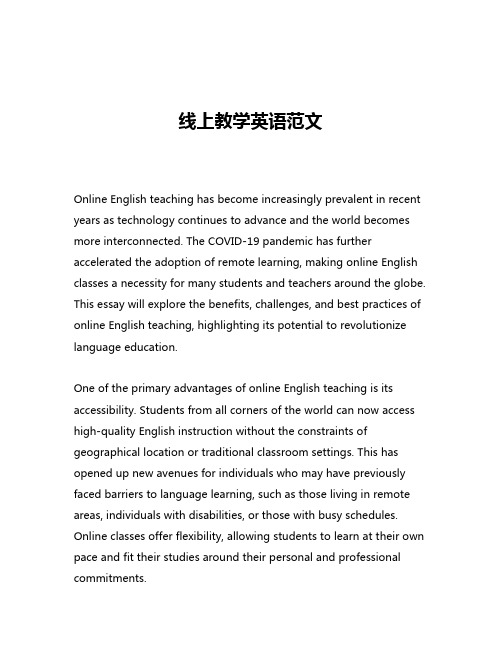
线上教学英语范文Online English teaching has become increasingly prevalent in recent years as technology continues to advance and the world becomes more interconnected. The COVID-19 pandemic has further accelerated the adoption of remote learning, making online English classes a necessity for many students and teachers around the globe. This essay will explore the benefits, challenges, and best practices of online English teaching, highlighting its potential to revolutionize language education.One of the primary advantages of online English teaching is its accessibility. Students from all corners of the world can now access high-quality English instruction without the constraints of geographical location or traditional classroom settings. This has opened up new avenues for individuals who may have previously faced barriers to language learning, such as those living in remote areas, individuals with disabilities, or those with busy schedules. Online classes offer flexibility, allowing students to learn at their own pace and fit their studies around their personal and professional commitments.Furthermore, online English teaching has the potential to provide a more personalized learning experience. With the use of interactive platforms and one-on-one instruction, teachers can tailor their approach to the unique needs and learning styles of each student. This personalization can lead to increased engagement, motivation, and ultimately, more effective language acquisition. Additionally, online platforms often offer a wide range of supplementary resources, such as virtual language labs, interactive exercises, and multimedia content, which can further enhance the learning experience.Another significant benefit of online English teaching is the opportunity for cultural exchange and global collaboration. In a virtual classroom, students can connect with peers from diverse backgrounds, fostering cross-cultural understanding and exposure to different perspectives. This can be particularly valuable for language learning, as it allows students to practice their communication skills in a real-world context and gain a deeper appreciation for the nuances of the English language and its various dialects and accents.However, the transition to online English teaching has not been without its challenges. One of the primary concerns is the potential for a lack of personal connection and engagement between teachers and students. Building rapport and fostering a sense of communitycan be more challenging in a virtual setting, and maintaining student attention and motivation can require additional effort from instructors. Effective online teaching strategies, such as incorporating interactive activities, regular check-ins, and opportunities for collaborative learning, can help mitigate these challenges.Another challenge is the need for reliable technology and internet access. Students and teachers alike must have access to stable internet connections, appropriate devices, and user-friendly online platforms to ensure a seamless learning experience. Technical difficulties and connectivity issues can disrupt the flow of lessons and hinder the learning process. Addressing these technological barriers, either through the provision of resources or the implementation of contingency plans, is crucial for the success of online English teaching.Additionally, the assessment and evaluation of student progress in an online environment can present unique challenges. Traditional methods of assessment, such as in-person exams, may need to be adapted to the online format, requiring the development of secure and reliable assessment tools. Ensuring the integrity of assessments and maintaining academic honesty can be a significant concern in the online realm.Despite these challenges, online English teaching has the potential totransform the landscape of language education. By leveraging the power of technology, educators can create engaging, interactive, and accessible learning experiences that cater to the diverse needs of students. However, for online English teaching to reach its full potential, it is essential to address the challenges and implement best practices that ensure a high-quality and equitable learning experience for all.One such best practice is the incorporation of synchronous and asynchronous learning modes. Synchronous sessions, where students and teachers interact in real-time, can foster a sense of community and provide opportunities for immediate feedback and collaboration. Asynchronous learning, on the other hand, allows students to access course materials, complete assignments, and engage in self-paced activities at their convenience. By blending these two approaches, online English teaching can offer the best of both worlds, catering to different learning preferences and schedules.Another best practice is the investment in high-quality instructional design and content development. Online courses should be meticulously planned, with a clear learning objectives, engaging multimedia resources, and interactive activities that cater to various learning styles. Effective online instructors should also be trained in the art of virtual facilitation, developing skills in virtual body language, digital classroom management, and the use of variousonline teaching tools and platforms.Furthermore, the integration of formative and summative assessments is crucial for monitoring student progress and ensuring the effectiveness of online English teaching. Formative assessments, such as quizzes, discussions, and peer-to-peer feedback, can provide ongoing insights into student learning, allowing teachers to adjust their approach as needed. Summative assessments, such as final exams or projects, can measure the achievement of learning outcomes and inform future course design.Finally, the success of online English teaching is heavily dependent on the establishment of a supportive and inclusive learning community. Fostering a sense of belonging and encouraging peer-to-peer interactions can help mitigate feelings of isolation and promote a more engaging and collaborative learning environment. Online instructors should prioritize creating opportunities for students to connect, share their experiences, and support one another throughout their language learning journey.In conclusion, online English teaching has the potential to revolutionize language education by providing accessible, personalized, and globally connected learning experiences. While there are challenges to overcome, such as maintaining engagement, addressing technological barriers, and ensuring effective assessment,the implementation of best practices can help unlock the full potential of this transformative approach to language learning. As the world continues to evolve, online English teaching will undoubtedly play an increasingly vital role in shaping the future of language education.。
介绍网上授课英语作文
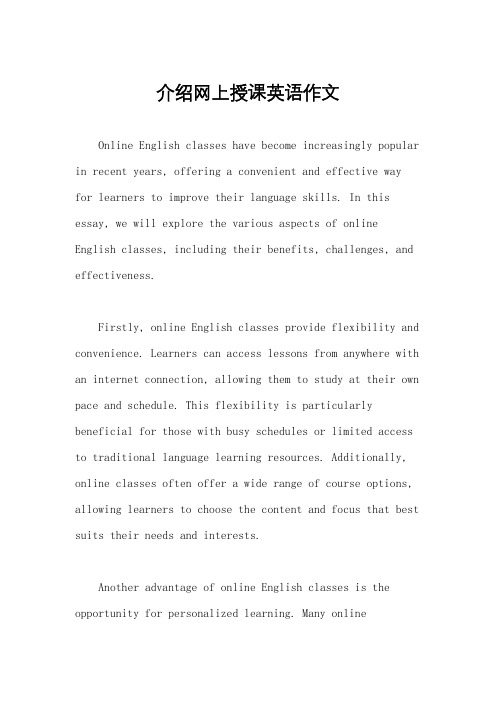
介绍网上授课英语作文Online English classes have become increasingly popular in recent years, offering a convenient and effective wayfor learners to improve their language skills. In this essay, we will explore the various aspects of online English classes, including their benefits, challenges, and effectiveness.Firstly, online English classes provide flexibility and convenience. Learners can access lessons from anywhere with an internet connection, allowing them to study at their own pace and schedule. This flexibility is particularly beneficial for those with busy schedules or limited access to traditional language learning resources. Additionally, online classes often offer a wide range of course options, allowing learners to choose the content and focus that best suits their needs and interests.Another advantage of online English classes is the opportunity for personalized learning. Many onlineplatforms utilize technology such as artificialintelligence and machine learning algorithms to tailor lessons to each learner's level, interests, and learning style. This personalized approach can help learners progress more quickly and effectively than traditional classroom instruction, as they receive targeted feedback and support.Furthermore, online English classes often provide access to a global community of learners and teachers. Through virtual classrooms, discussion forums, and social media groups, learners can connect with peers and educators from around the world, facilitating cultural exchange and language practice. This multicultural environment can enhance the learning experience and provide valuable opportunities for real-world communication.However, online English classes also present some challenges. One common concern is the lack of face-to-face interaction with teachers and classmates. While virtual classrooms and video conferencing technology can facilitate communication, some learners may struggle to developspeaking and listening skills without in-person interaction. Additionally, technical issues such as poor internet connection or software glitches can disrupt the learning process and frustrate learners.Another challenge is maintaining motivation and accountability in an online learning environment. Withoutthe structure and accountability of traditional classroom settings, some learners may struggle to stay engaged and disciplined. To address this challenge, online platforms often incorporate features such as progress tracking, gamification, and peer support to motivate learners and foster a sense of community.Despite these challenges, research suggests that online English classes can be highly effective for language learning. A study published in the "Journal of Computer-Assisted Learning" found that learners in online language courses achieved similar levels of proficiency as those in traditional classroom settings. Additionally, a meta-analysis of research on online language learning concluded that online instruction can be as effective as face-to-faceinstruction when implemented properly.In conclusion, online English classes offer a convenient, flexible, and effective way for learners to improve their language skills. While they may present some challenges, such as the lack of face-to-face interaction and maintaining motivation, online classes provide numerous benefits, including personalized learning, access to a global community, and opportunities for cultural exchange. With the continued advancement of technology and online learning platforms, the future of online English classes looks promising for learners around the world.。
在线更容易教学英语作文
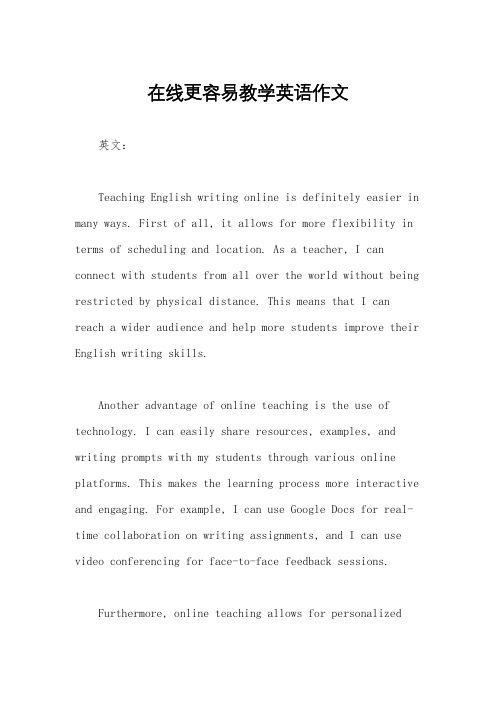
在线更容易教学英语作文英文:Teaching English writing online is definitely easier in many ways. First of all, it allows for more flexibility in terms of scheduling and location. As a teacher, I can connect with students from all over the world without being restricted by physical distance. This means that I can reach a wider audience and help more students improve their English writing skills.Another advantage of online teaching is the use of technology. I can easily share resources, examples, and writing prompts with my students through various online platforms. This makes the learning process more interactive and engaging. For example, I can use Google Docs for real-time collaboration on writing assignments, and I can use video conferencing for face-to-face feedback sessions.Furthermore, online teaching allows for personalizedand individualized instruction. I can tailor my teaching approach to meet the specific needs and learning styles of each student. For instance, some students may benefit from more visual aids, while others may prefer more verbal explanations. Online teaching enables me to adapt to these preferences and provide a more customized learning experience.In addition, online teaching also encourages independent learning and self-discipline. Since students have to manage their own time and stay motivated without the physical presence of a teacher, they can develop important skills such as time management and self-motivation. This is especially important for writing, as it requires a lot of practice and self-directed learning.Overall, I believe that online teaching offers a lot of benefits for teaching English writing. It allows for more flexibility, utilizes technology for a more interactive learning experience, and enables personalized instruction. However, it's important to note that online teaching also comes with its own set of challenges, such as technologicalissues and the lack of face-to-face interaction. 。
英语作文线上授课模板
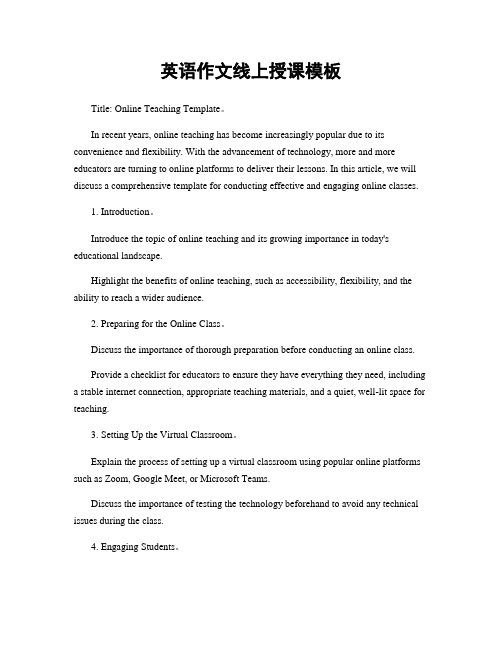
英语作文线上授课模板Title: Online Teaching Template。
In recent years, online teaching has become increasingly popular due to its convenience and flexibility. With the advancement of technology, more and more educators are turning to online platforms to deliver their lessons. In this article, we will discuss a comprehensive template for conducting effective and engaging online classes.1. Introduction。
Introduce the topic of online teaching and its growing importance in today's educational landscape.Highlight the benefits of online teaching, such as accessibility, flexibility, and the ability to reach a wider audience.2. Preparing for the Online Class。
Discuss the importance of thorough preparation before conducting an online class.Provide a checklist for educators to ensure they have everything they need, including a stable internet connection, appropriate teaching materials, and a quiet, well-lit space for teaching.3. Setting Up the Virtual Classroom。
线上教学英语作文模板范文
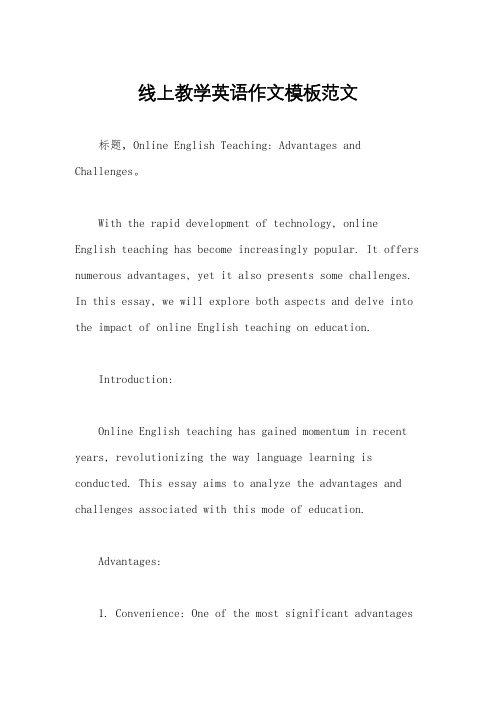
线上教学英语作文模板范文标题,Online English Teaching: Advantages and Challenges。
With the rapid development of technology, online English teaching has become increasingly popular. It offers numerous advantages, yet it also presents some challenges. In this essay, we will explore both aspects and delve into the impact of online English teaching on education.Introduction:Online English teaching has gained momentum in recent years, revolutionizing the way language learning is conducted. This essay aims to analyze the advantages and challenges associated with this mode of education.Advantages:1. Convenience: One of the most significant advantagesof online English teaching is its convenience. Learners can access lessons from anywhere with an internet connection, eliminating the need for physical attendance. Thisflexibility allows students to schedule their learning around other commitments, making education more accessible to a wider audience.2. Cost-effectiveness: Compared to traditional classroom-based learning, online English teaching often proves to be more cost-effective. There are fewer overhead expenses associated with maintaining physical infrastructure, and resources can be easily shared and distributed digitally. This affordability opens up opportunities for individuals who may not have been able to afford traditional language classes.3. Access to resources: Online English teaching platforms provide access to a wide range of resources, including multimedia materials, interactive exercises, and virtual classrooms. These resources are often updated regularly to reflect current language trends and cater to different learning styles. Additionally, students canbenefit from a diverse pool of instructors from around the world, exposing them to various accents and teaching methodologies.4. Flexibility in learning pace: In a traditional classroom setting, the pace of learning is often dictated by the majority of students. However, with online English teaching, learners have the freedom to progress at their own pace. They can revisit challenging concepts, review materials as needed, and tailor their learning experience to suit their individual needs and preferences.Challenges:1. Technological limitations: Despite the advancements in technology, online English teaching still faces challenges related to infrastructure and connectivity. Not all learners have access to reliable internet connections or the necessary devices to participate fully in virtual lessons. Technical glitches and compatibility issues can also disrupt the learning process, leading to frustration and disengagement.2. Lack of face-to-face interaction: While online English teaching offers convenience, it lacks the interpersonal connection that comes with face-to-face interaction. Non-verbal cues, such as body language and facial expressions, play a crucial role in communication and comprehension. The absence of these cues in virtual settings can hinder language acquisition and make it challenging for students to develop fluency and confidence in speaking.3. Potential for distractions: Learning in an online environment can expose students to various distractions, such as social media, emails, or household chores. Without the physical presence of a teacher to monitor their progress, students may find it difficult to stay focused and motivated during online lessons. Additionally, the temptation to multitask can detract from the quality of learning and hinder academic performance.4. Limited opportunities for real-world practice: Despite the abundance of online resources, online Englishteaching may not always provide sufficient opportunitiesfor real-world language practice. Language proficiency is best acquired through immersive experiences, such as interacting with native speakers or participating in group discussions. Virtual classrooms may not always replicate these authentic language contexts, limiting students' exposure to real-life communication scenarios.Conclusion:In conclusion, online English teaching offers numerous advantages, including convenience, cost-effectiveness, access to resources, and flexibility in learning pace. However, it also presents challenges such as technological limitations, lack of face-to-face interaction, potentialfor distractions, and limited opportunities for real-world practice. Educators and policymakers must address these challenges proactively to maximize the benefits of online English teaching and ensure equitable access to quality language education for all learners. By leveraging technology effectively and incorporating best practices in online pedagogy, we can harness the power of online Englishteaching to empower individuals and foster global communication and understanding.。
网上有人讲课吗英语作文
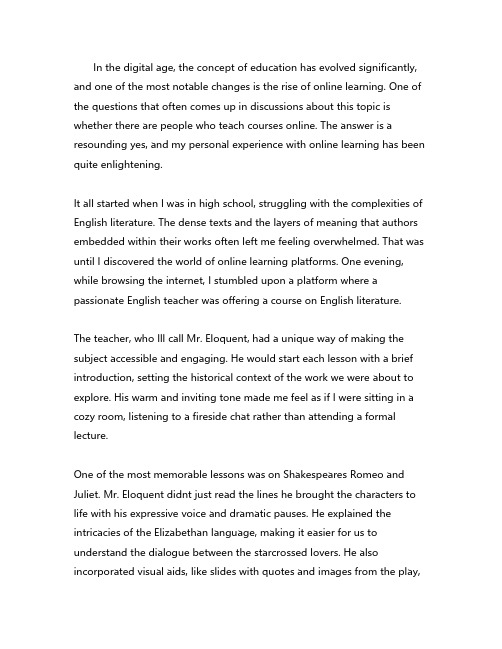
In the digital age, the concept of education has evolved significantly, and one of the most notable changes is the rise of online learning. One of the questions that often comes up in discussions about this topic is whether there are people who teach courses online. The answer is a resounding yes, and my personal experience with online learning has been quite enlightening.It all started when I was in high school, struggling with the complexities of English literature. The dense texts and the layers of meaning that authors embedded within their works often left me feeling overwhelmed. That was until I discovered the world of online learning platforms. One evening, while browsing the internet, I stumbled upon a platform where a passionate English teacher was offering a course on English literature.The teacher, who Ill call Mr. Eloquent, had a unique way of making the subject accessible and engaging. He would start each lesson with a brief introduction, setting the historical context of the work we were about to explore. His warm and inviting tone made me feel as if I were sitting in a cozy room, listening to a fireside chat rather than attending a formal lecture.One of the most memorable lessons was on Shakespeares Romeo and Juliet. Mr. Eloquent didnt just read the lines he brought the characters to life with his expressive voice and dramatic pauses. He explained the intricacies of the Elizabethan language, making it easier for us to understand the dialogue between the starcrossed lovers. He also incorporated visual aids, like slides with quotes and images from the play,which helped to create a vivid picture in my mind.What set Mr. Eloquent apart from traditional classroom teachers was his approach to interaction. He encouraged us to participate in live chats during the lessons, where we could ask questions and share our thoughts. This was a refreshing change from the usual classroom setting, where students often hesitate to speak up for fear of being judged by their peers.Moreover, the online platform provided a wealth of resources that I could access at any time. There were supplementary readings, video clips of performances, and even interactive quizzes that tested my understanding of the material. This flexibility allowed me to learn at my own pace, revisiting lessons when I needed to and delving deeper into topics that piqued my interest.Another advantage of online learning was the diversity of perspectives. Students from different parts of the world were enrolled in the course, and during our discussions, we shared insights from our own cultures and experiences. This exchange enriched my understanding of the texts, as I was exposed to interpretations that I might not have considered otherwise.However, its worth noting that online learning isnt without its challenges. There were times when the lack of facetoface interaction made it difficult to gauge Mr. Eloquents reactions to our comments or questions. Additionally, the selfdirected nature of the course required a high level of discipline and motivation, as there was no one to hold us accountable for our progress.In conclusion, my experience with online learning has been overwhelmingly positive. It has shown me that there are indeed passionate and knowledgeable individuals, like Mr. Eloquent, who are dedicated to sharing their expertise through the internet. The convenience, flexibility, and global reach of online courses have opened up a world of opportunities for students like me, who are eager to learn but may be constrained by geographical or financial limitations. As technology continues to advance, I believe that online learning will play an increasingly important role in shaping the future of education.。
